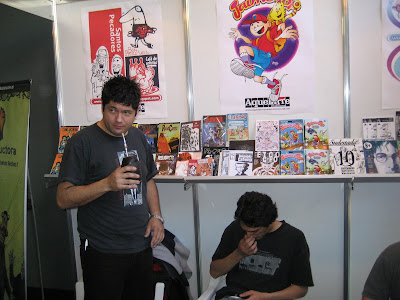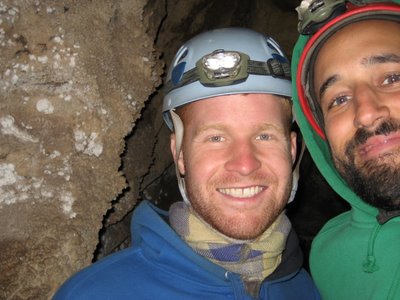





Comics, education, family, politics





Because of limited job markets, many Argentine comic creators, including Productora artists Cristian Mallea and Angel Mosquito, started offering workshops for students of all ages. I visited these workshops a couple times. I volunteered to translate some key ideas from a comics essay on manga, or Japanese comics, from Scott McCloud’s new book Making Comics and lead a chat on the topic. About 10 students and 3 Productora artists/teachers attended.


After my presentation, they returned to business as usual and I got to see part of the learning process. The students and Mosquito sat in a circle. Mosquito went through each student’s work critiquing and complementing it as students chimed in occasionaly: “This looks rushed”, “Why did you choose an old style train?”. While teaching can be tiring, Mosquito and Crisitan enjoy seeing kids grow over the years as they apply the tools they learned in class to their own ideas.

PICS OF MONTEVIDEO COMICS
A bunch of writers, artists and friends getting together for asado before the convention Montevideo Comics.



Crisitan Mallea of La Productora sipping some mate in front of his stand.


Calero, Uruguayan artist who worked on Captain America, drawing pictures for fans. In the back, a blow-up of a page from Crimenes, that Calero created with Rodolfo Santullo under independent label Grupo Belerofonte.
 PRODUCTORA TALLER PICS
PRODUCTORA TALLER PICS


10. X
9. Kevin Coyne
8. Flamin’ Groovies
7. Pogues
6. Zappa
5. Tall Dwarves
4. Half Japanese
3. Pere Ubu
2. Modern Lovers
1. Roky Erickson


In the above comic excerpt, you get a sense of how a couple of Argentines see Argentine schools. This image comes from issue #2 of the recently initiated second volume of the legendary magazine Fierro. In this particulary story, cartoon versions of the writer and artist (Carlos Trillo and Oscar Grillo) are mysteriously transported back to their childhood lives and forced to relive that world with an adult perspective.
The school I visited (in which my cousin teachers) was formatted a bit like the one above, with dilapidated classrooms surrounding an inner courtyard. Note the prominent Argentine flag.
You could read about the original Fierro in the Rennaisance section I added (along with the Self-Publishing section) on the Argentine Comics Wikipedia page.



En un asado en la casa de Dani, el primo de mi madre, aprendí cosas Argentinas muy importantes. El es muy orgulloso de de sue parrilla, pero no es por ser fanfarrón; el lo diseñó y es
Muchas veces, el orgullo que merece la Argentinidad (que recibí de mis abuelos) me ayuda en conectar con la gente. Pero, muchas cosas todovía me cuesta. En este post podés ver que no escribo perfecto sin diccionario ni ayuda. Tampoco sé si es rudo llamar a alguien boludo en el internet, pero imagino que todos entienden que lo digo con cariño y amor.
Tambien tomo mate cada mañana.
For my past few times volunteering, I was the only teacher and I made up the lesson from scratch. There are usually about 10 kids, ages 8-12. On one trip, I used flash cards that other volunteers designed and focused on vocabulary, pronunciation, numbers and asking “how many…?”.
Before leaving, I asked the kids “Why is it good for you to learn English?” Not feeling ready to engage them in a conversation about the role of the
I’ve been writing in my journal since 7th grade, but this blog is the first time I’ve shared my writing with anyone outside of a classroom. Building on the advice of friends and remembering that I don’t read long-winded blogs, I’ve been writing shorter, more frequent posts. That last (big) post about Montevideo took so long because I wanted to check some facts, but I eventually thought it was better to just keep writing. Other times, I get distracted by Internet bells & whistles.
When these things happen, I think about James Kochalka. He is my favorite current comics artist and Internet journal writer. Reading his daily postings, you get a sense of what he is about and you also see a lot of crap. You see him complain about his crap too. In short, James rules!! You can check out the link above, but to really appreciate him, you have to read the collected works.

I went to a comics convention in


At one of the convention’s organized chats, another local creator said that all manga is the same. One costumed kid got really flustered and asked the creator if he had ever read manga. He admitted that he hadn’t.




On Saturday, we had a big family reunion at my grandmother’s sister's house. It was great to see my mom and family smile as much as they did. The evening climaxed with everyone singing Argentine songs, including "Luna Tucumana" by folk legend Mercedes Sosa.
Later that night, I ran into some Pennsylvanians at a bar and did a little Cleveland-Pittsburg football rivalry thing. It was nice getting to act out a script with people I don’t know. Granted, I could care less about football, but it was nice for a moment.
I couldn’t help but rent “24 hour Party People” (which isn't actually a documentary, but historical fiction), as any semi-responsible student of the social sciences must understand the historical context of his or her cultural experiences. While I was being born in 1982, New Order record sales funded the legendary Haçienda nightclub in


Traveling through the mountainous Cuyo region of
 Caverna de Las Brujas (Cave of the Witches). Outside of Malargue, Mendoza.
Caverna de Las Brujas (Cave of the Witches). Outside of Malargue, Mendoza. Rafting in Rio Atuel. Valle Grande, outside of San Rafael, Mendoza.
Rafting in Rio Atuel. Valle Grande, outside of San Rafael, Mendoza. Rappelling. Valle Grande.
Rappelling. Valle Grande. Horse-back riding. Valle Grande.
Horse-back riding. Valle Grande. "Just put on this gear and run down the mountain until you fly."
"Just put on this gear and run down the mountain until you fly." "Do you like Adrenaline?" the instructor Juan asked me.
"Do you like Adrenaline?" the instructor Juan asked me. Relaxing in Parque San Martin in the city of Mendoza.
Relaxing in Parque San Martin in the city of Mendoza. I met Cristian Mallea of La Productora independent publishing collective, right, at this event sponsored by the government of the city of Mendoza. He invited me to an event at a local comic store later that day and eventually to a convention in Montevideo, Uruguay.
I met Cristian Mallea of La Productora independent publishing collective, right, at this event sponsored by the government of the city of Mendoza. He invited me to an event at a local comic store later that day and eventually to a convention in Montevideo, Uruguay.




